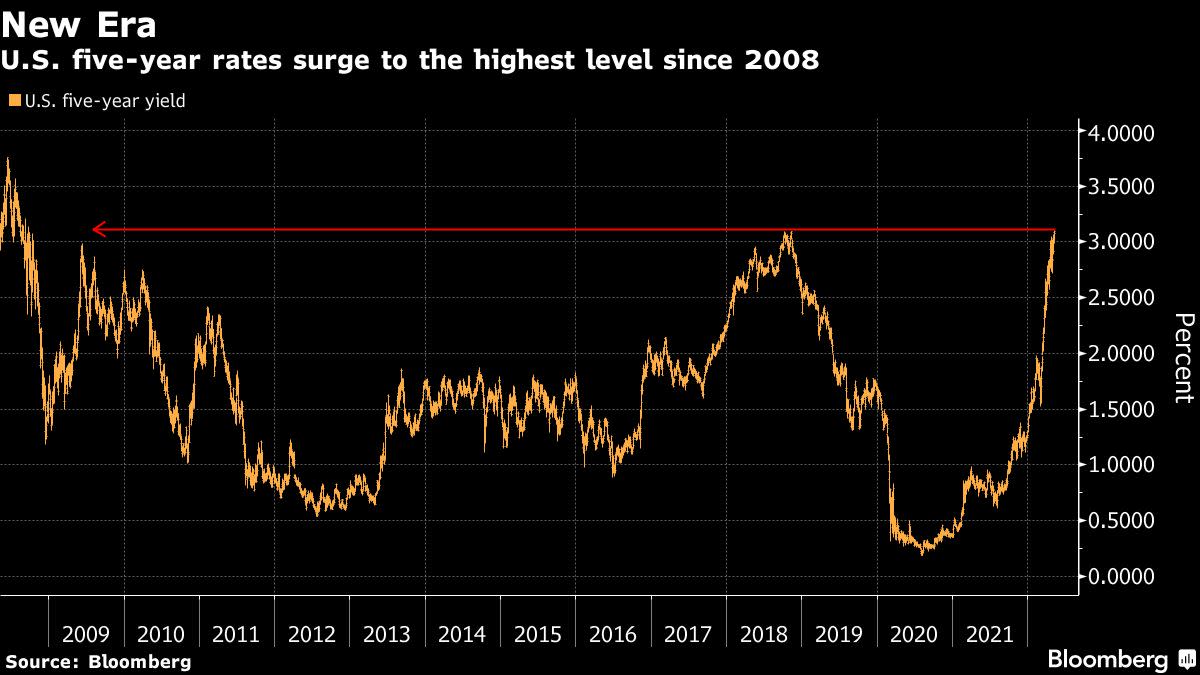
(Bloomberg) — U.S. Treasuries tumbled Monday, driving the yield on five-year notes to the highest level since September 2008 amid speculation persistent inflation will prompt the Federal Reserve to tighten policy more aggressively.
The yield jumped as much as three basis points to 3.11%, extending an advance that has seen the rate more than double this year. The curve steepened as 10- and 30-year bonds underperformed. While Federal Reserve Chair Jerome Powell last week played down the option of a jumbo 75 basis-point rate hike, Richmond Fed President Thomas Barkin said in an interview on Friday that nothing was off the table.
The milestone caps a remarkable selloff in government bonds as central banks round the world pare pandemic-era stimulus to tackle scorching inflation, and comes as investors wait for April U.S. consumer-price data due Wednesday. The Fed has raised rates by 75 basis points so far this year and signaled more tightening to tame inflation now running at the fastest pace in 40 years.
Bond Market Burned by Fed’s Liftoff Struggles to See End to Pain
“The market still remains in poor shape,” said Christoph Rieger, head of fixed-rate strategy at Commerzbank AG. “It is remarkable that the post-Fed sell-off has actually been driven by long-end real yields. This points towards the market re-assessing the terminal rate that is needed to get inflation under control.”
The pace of the rout has caught many traders off-guard. Only just over a week ago, a survey by Bloomberg’s Market Live showed 24% of readers thought 10-year yields wouldn’t break above 3.15% this year. They rose seven basis points to 3.20% on Monday. The 10-year real yield has surged to 0.3%, a level last seen before the pandemic in July 2019.
“The market appeared to start coming around to our view that the Fed has much more tightening to do,” Deutsche Bank strategists including Jim Reid wrote wrote in a note, commenting on last week’s moves.
Traders are fully pricing further half-point hikes at the Fed’s next two decisions, with around 200 basis points of tightening seen between now and the end of the year.
Stagflation Makes for Summer of Discontent With Nowhere to Hide
Yields may also be under upward pressure across the curve this week as the Treasury department will auction three-, 10- and 30-year debt worth $103 billion in total.
Still, a slowdow in inflation could provide a ray of hope for markets and help them stabilize, Commerzbank’s Rieger added. Consumer prices are expected to rise an annual 8.1% in April, compared to 8.5% in March, according to the median estimate in a Bloomberg survey.
“For the first time in a long time, bonds are beginning to look reasonably attractive from a longer term perspective,” said Dan Ivascyn, the chief investment officer at Pacific Investment Management Co.
European Rout
European government bonds were also under pressure, with Italian debt under performing again on Monday. European Central Bank Governing Council member Olli Rehn said policy markers should start raising rates in July to prevent inflation expectations becoming de-anchored.
The yield on 10-year Italian government bonds rose as much as nine basis points to 3.22% before falling back. The spread over the equivalent German bond widened to as much as 207 basis points, after breaching a key level last week.
“We have already suggested that the combination of a growth slow-down into which the ECB will hike, and the reduction in liquidity provision will have — potentially severe — negative repercussions for spread markets,” Peter Schaffrik, global macro strategist at RBC Capital Markets, wrote in a note.
He expects sovereign and credit spreads to widen further, with the spread on 10-year Italian and German bonds widening to around 250 basis points.
©2022 Bloomberg L.P.